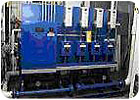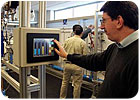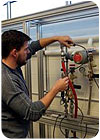
A Metropolitan Variapac System 2000 booster system responsible for supplying separate pressures of hot and cold water during testing of various plumbing fixtures such as flush valves, shower valves, spray valves and sink fittings.
To help its new test lab maintain constant pressure at +/- 2PSI or better using multiple pressure zones, TCFC installs a booster system designed and manufactured by Metropolitan Industries, Inc.
With the explosion in technology witnessed during the last decade, many companies are discovering new and inventive ways to test their products. Given the high costs of obtaining third party certification, companies want to know their products will pass strict testing standards before delivering their product to an accredited test lab. Failure to pass a certification test on the first attempt means paying again to resubmit the product and a loss of valuable time on a project.
Companies realize that the high price invested up front in a test center will ultimately save them thousands of dollars. With a high-tech test lab, company engineers can exceed the testing requirements of domestic standards, as well as those produced by other countries, societies and engineers.
The Chicago Faucet Company (TCFC) located in Des Plaines, IL, recently took a giant leap forward and upgraded their existing research and development capabilities with the installation of a modern testing facility unique in every way.
This testing facility incorporates and harnesses technology found mainly in large-scale municipal applications using multiple pressure zones and applies it to an area measuring the size of a large living room. The result is a system that allows TCFC to test, precisely, multiple products concurrently, with each product requiring its own precise pressure.
Company History
TCFC opened its doors in 1901 on Chicago's west side. Founded by Albert C. Brown, the company is as much of a Chicago icon as any other famous Chicago business.In 2002, The Geberit Group, a company headquartered in Jona, Switzerland, acquired Chicago Faucets. They now employ over 500 people in North America with operations located in Des Plaines, Ill., Milwaukee, Elyria, OH. and Michigan City, Ind. The company is a leader in supplying plumbing fittings for the commercial, laboratory, food service, safety and residential markets.
Out-Dated Test Lab
Before computers dominated most aspects of day-to-day business operations, TCFC, like most companies, worked with technology available to them at the moment. In the world of testing plumbing fittings, equal distribution of water and precise pressurization to all fittings is essential. modern facility.When originally installed a decade ago, the TCFC's test lab was innovative but time saw its usefulness decline. TCFC's previous test lab was unable to achieve the precision needed to test new technologies being developed for today's market. This led to the consideration of a modern facility.
Chicago Faucet hired Tim Smith CPD, of Metro Design located in Schaumburg, Ill., to design a new plumbing system for the lab. According to Smith, the existing system used two multi-stage vertical turbine pumps controlled by old inverter technology or first-generation variable control.
"This system was not functional for them because of its inability to control pressures,"

Chicago Faucet's Product Compliance and Testing Coordinator Larry Himmelblau demonstrates the test lab's touch screen controller that allows engineers to vary pressures to a particular zone and see the entire system status with a touch of a button.
- Ability to maintain constant pressure at +/-2 PSI.
- Ability to match performance of certification test labs including Canadian Standards Association (CSA), International Association of Plumbing and Mechanical Officials (IAPMO), and the American Society of Plumbing Engineers (ASPE).
- Integrate touch screen operations that incorporate the latest monitoring and trending technology similar to Supervisory, Control and Data Acquisition systems found in most municipalities.
"One of my concerns was the ability to stay flexible. The use an aluminum racking system achieved this by allowing us to test multiple products and expand as needed,"
Constant Pressure "The Key"
In order to properly develop new products and impose the same testing criteria as CSA, IAPMO, ASPE and ASSE, engineers needed the test lab to maintain constant pressure at +/- 2PSI or better using multiple pressure zones. This posed a design challenge because of the sheer difference of gallons per minute and pressures each separate zone demanded. In some cases, a particular zone could see fluctuations as much as 75GPM in a few seconds."Himmelblau wanted the ability to life cycle test multiple fixtures at one time so constant pressure fittings was a must,"

Chicago Faucet Engineer Ryan Schlangen attaches a pressure transducer to a shower valve in order to monitor results using their data acquisition system.
The key to integrating the control program was combing both the five pressure-regulating valves (with a future sixth) and 4 variable frequency drives in order to maintain proper pressure as required per zone. Scoleri used the drives to maintain a constant header pressure so that the valves had an easier job of maintaining pressure to the fixtures. This extends the life of the system by preventing sudden changes in pressures.
The electronic zone, pilot operated, pressure regulating valves open and close according to pressure requirements. They operate simultaneously and independently of one another to provide vastly different flows and pressures. Each valve has the task of adjusting and maintaining pressure in its own zone.
A favorite feature of TCFC engineers is the color, touch screen control panel that controls the entire system with a tap of a finger. From the touch screen, engineers can vary pressure to a particular zone, trend a particular period of time, monitor pressures and flows, clear and monitor alarms and see the entire system status. Utilizing color graphics and charts, an engineer can quickly assess how testing is proceeding.
"It is very easy to control the pressures in five different zones within the three test areas using the control panel,"